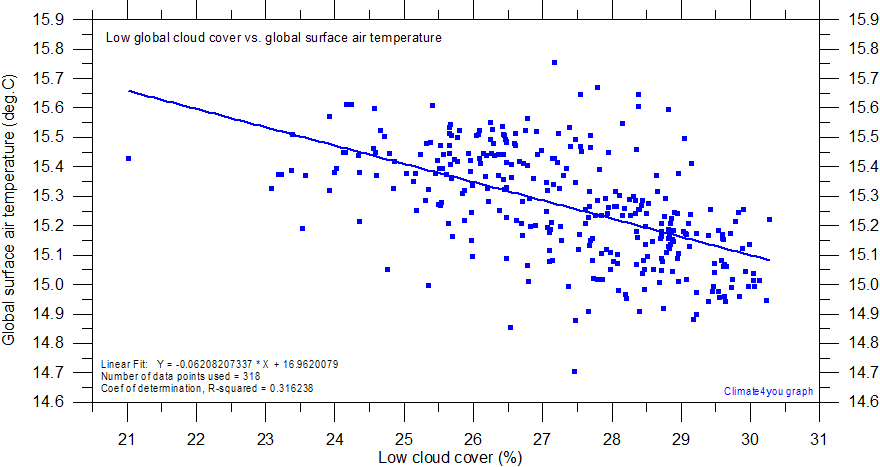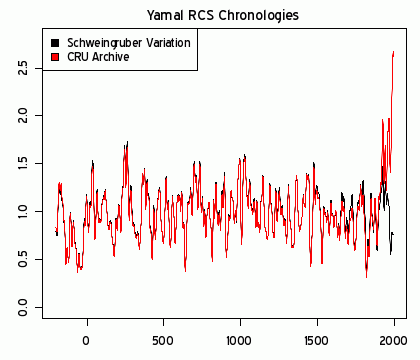October 9, 2009
Yamal cherry picking
[I'm late on the Yamal tree ring story -- 'been away for two weeks -- but I'm including it here for completeness]
"Most of the proxy data does not show anything unusual about the 20th century. But two data series have reappeared over and over that do have a hockey stick shape. One was the flawed bristlecone data that the National Academy of Sciences panel said should not be used, so the studies using it can be set aside. The second was a tree ring curve from the Yamal Peninsula in Siberia, compiled by UK scientist Keith Briffa.
Briffa had published a paper in 1995 claiming that the medieval period actually contained the coldest year of the millennium. But this claim depended on just three tree ring records (called cores) from the Polar Urals. Later, a colleague of his named F. H. Schweingruber produced a much larger sample from the Polar Urals, but it told a very different story: The medieval era was actually quite warm and the late 20th century was unexceptional. Briffa and Schweingruber never published those data, instead they dropped the Polar Urals altogether from their climate reconstruction papers.
In its place they used a new series that Briffa had calculated from tree ring data from the nearby Yamal Peninsula that had a pronounced Hockey Stick shape: relatively flat for 900 years then sharply rising in the 20th century. This Yamal series was a composite of an undisclosed number of individual tree cores. In order to check the steps involved in producing the composite, it would be necessary to have the individual tree ring measurements themselves. But Briffa didn’t release his raw data.
Over the next nine years, at least one paper per year appeared in prominent journals using Briffa’s Yamal composite to support a hockey stick-like result. The IPCC relied on these studies to defend the Hockey Stick view, and since it had appointed Briffa himself to be the IPCC Lead Author for this topic, there was no chance it would question the Yamal data.
Despite the fact that these papers appeared in top journals like Nature and Science, none of the journal reviewers or editors ever required Briffa to release his Yamal data. Steve McIntyre’s repeated requests for them to uphold their own data disclosure rules were ignored.
Then in 2008 Briffa, Schweingruber and some colleagues published a paper using the Yamal series (again) in a journal called the Philosophical Transactions of the Royal Society, which has very strict data-sharing rules. Steve sent in his customary request for the data, and this time an editor stepped up to the plate, ordering the authors to release their data. A short while ago the data appeared on the Internet. Steve could finally begin to unpack the Yamal composite.
It turns out that many of the samples were taken from dead (partially fossilized) trees and they have no particular trend. The sharp uptrend in the late 20th century came from cores of 10 living trees alive as of 1990, and five living trees alive as of 1995. Based on scientific standards, this is too small a sample on which to produce a publication-grade proxy composite. The 18th and 19th century portion of the sample, for instance, contains at least 30 trees per year. But that portion doesn’t show a warming spike. The only segment that does is the late 20th century, where the sample size collapses. Once again a dramatic hockey stick shape turns out to depend on the least reliable portion of a dataset.
But an even more disquieting discovery soon came to light. Steve searched a paleoclimate data archive to see if there were other tree ring cores from at or near the Yamal site that could have been used to increase the sample size. He quickly found a large set of 34 up-to-date core samples, taken from living trees in Yamal by none other than Schweingruber himself! Had these been added to Briffa’s small group the 20th century would simply be flat. It would appear completely unexceptional compared to the rest of the millennium [see graph].
Combining data from different samples would not have been an unusual step. Briffa added data from another Schweingruber site to a different composite, from the Taimyr Peninsula. The additional data were gathered more than 400 km away from the primary site. And in that case the primary site had three or four times as many cores to begin with as the Yamal site. Why did he not fill out the Yamal data with the readily-available data from his own coauthor? Why did Briffa seek out additional data for the already well-represented Taimyr site and not for the inadequate Yamal site?
Thus the key ingredient in most of the studies that have been invoked to support the Hockey Stick, namely the Briffa Yamal series, depends on the influence of a woefully thin subsample of trees and the exclusion of readily-available data for the same area. Whatever is going on here, it is not science." "Ross McKitrick: Defects in key climate data are uncovered"
-
http://heliogenic.blogspot.com/2009/10/yamal-cherry-picking.html
Posted by jblethen at 10/09/2009






